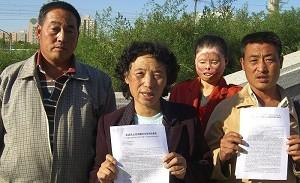Approximately 200 demonstrators gathered on Beijing’s Tiananmen Square on the 18th anniversary of the 1989 June 4 Massacre. Police immediately arrested all the demonstrators.
The demonstrators formed groups around the Great Flagpole, in front of the Great Hall of the People, and at the Monument to the People’s Heroes.
Police, who were out in force on the Square to prevent demonstrations, surrounded and seized the demonstrators as soon as they assembled.
Police vans and buses were parked around the Square, and police were searching the bags of everyone trying to enter the Square, looking for banners or signs.
Tiananmnen Square, while open to the public, can only be accessed through a series of narrow tunnels. This makes it easy for police to control the area and search visitors.
The 1989 Tiananmen Square Massacre
Tiananmen Square was the site of months-long demonstrations following the death Communist Party Secretary General Hu Yaobang, who had called for reform and a condemnation of the policies and programs of the Mao era. Hu was denounced by the Chinese Communist Party, (CCP) but was revered by the Chinese people for trying to change the bloody reign of the CCP.

After Hu’s death due to heart attack on April 15, 1989, college students filled Tiananmen Square, honoring Hu’s efforts and calling for the CCP to reform its view of Hu. Similar demonstrations erupted all over China, notably in Shanghai.
CCP Secretary General Zhao Ziyang symapathized with the demostrators and reccomended a peaceful resolution, for which he was deposed.
The students remained on Tiananmen until the night of June 3-4, when then-Secretary of the CCP Central Military Commission Deng Xiaoping ordered the army to clear the Square. The army sent infantry and tanks, which were met in the streets by crowds of ordinary citizens who, while not joining in the Tiananmen Square protest, did not want to see the students gunned down. The army opened fire on the civilians, killing and wounding thousands.

The army finally reached Tiananmen Square and cleared it. Final casualty figures are unknown—best estimates place the number of dead between one and three thousand.
The CCP denied that any demonstrators were killed, and instead claimed that the demonstrators had attacked the soldiers, killing some. The CCP held to this line for many years, despite photo and video evidence of the shootings.

Many Chinese have called for the government to revise its official position on the Tiananmen Massacre. Many Chinese also desire to see policies of reform and democratization, similar to those suggested by Secretary General Hu in 1989, implemented in China.
According to major human rights groups, China is instead becoming more repressive, with a sharp increase in human rights violations as the CCP tries to quell all dissent prior to the 2008 Beijing Olympics.
 A girl wounded during the clash between the army and students June 4, 1989 near Tiananmen Square is carried out by rickshaw driver. Manuel Ceneta/AFP/Getty Images |  People's Liberation Army (PLA) tanks guard a strategic Chang'an Avenue leading to Tiananmen Square June 6, 1989. Manuel Ceneta/AFP/Getty Images |




